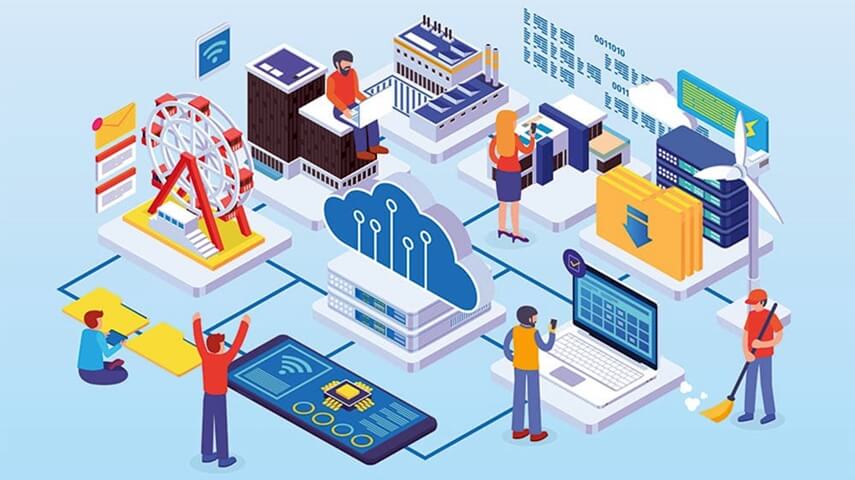Enterprise Resource Planning (ERP) systems have long been a cornerstone of efficient business operations, helping companies manage everything from finances and human resources to supply chain and customer relationships. However, traditional ERP systems often come with substantial upfront costs and complex implementations. Enter Cloud ERP solutions, which are revolutionizing the way businesses operate by providing a more flexible, scalable, and cost-effective approach to managing their resources. In this article, we will delve into the world of Cloud ERP solutions, exploring their benefits, key features, and the steps to successful implementation.
Understanding Cloud ERP
Before we dive into the benefits and features of Cloud ERP solutions, let’s clarify what they are. ERP, in general, is a comprehensive suite of integrated business applications designed to streamline and automate various business processes across an organization. These processes typically include accounting, finance, human resources, supply chain management, customer relationship management, and more.
Traditional ERP systems are on-premises solutions, meaning they are hosted and maintained within a company’s own data centers. In contrast, Cloud ERP solutions are hosted in the cloud by a third-party provider. This fundamental difference in deployment has significant implications for businesses of all sizes.
The Benefits of Cloud ERP Solutions
Cost-Efficiency
One of the primary advantages of adopting a Cloud ERP solution is the cost-efficiency it offers. Traditional ERP implementations can be capital-intensive, requiring substantial upfront investments in hardware, software licenses, and IT staff to manage and maintain the system. Cloud ERP eliminates these upfront costs by offering a subscription-based pricing model. Companies pay for what they use, and the cloud provider takes care of hardware maintenance and software updates. This shift from capital expenditures (CapEx) to operational expenditures (OpEx) can free up valuable financial resources for other strategic initiatives.
Scalability and Flexibility
Cloud ERP solutions are highly scalable and flexible. As your business grows or changes, you can easily adjust your subscription to accommodate new users, add functionality, or expand into new markets. This flexibility is particularly valuable in industries where seasonality and rapid growth are common. Traditional ERP systems often require significant time and effort to scale up, which can hinder business agility.
Accessibility and Collaboration
Cloud ERP solutions are accessible from anywhere with an internet connection. This accessibility is a game-changer for organizations with remote or distributed teams. Team members can access real-time data and collaborate seamlessly, whether they are in the office, at home, or on the road. This level of accessibility can enhance decision-making and responsiveness, critical factors in today’s dynamic business landscape.
Automatic Updates and Maintenance
Cloud ERP providers take care of system updates and maintenance, ensuring that your software is always up to date and secure. This eliminates the need for in-house IT staff to manage these tasks, reducing operational overhead and freeing up IT resources for strategic projects.
Enhanced Security
Cloud ERP providers invest heavily in security measures to protect their clients’ data. They employ encryption, multi-factor authentication, and robust access controls to safeguard sensitive information. In many cases, cloud providers have more extensive security resources and expertise than individual organizations, making it challenging for cybercriminals to breach their systems.
Disaster Recovery and Business Continuity
Cloud ERP solutions typically include robust disaster recovery and backup capabilities. In the event of a data loss or system failure, your data is securely stored in multiple data centers, ensuring business continuity. This level of protection can be challenging and expensive to implement with on-premises ERP systems.
Key Features of Cloud ERP Solutions
Cloud ERP solutions come equipped with a wide range of features designed to streamline various aspects of business operations. While specific features can vary depending on the provider and the industry, here are some common components you can expect to find:
Financial Management
Cloud ERP systems offer robust financial management capabilities, including general ledger, accounts payable and receivable, budgeting, and financial reporting. These features help organizations maintain financial control, comply with regulations, and make informed financial decisions.
Supply Chain Management
Effective supply chain management is crucial for businesses to meet customer demands and control costs. Cloud ERP solutions provide tools for inventory management, order processing, demand forecasting, and supplier collaboration, enabling businesses to optimize their supply chain operations.
Human Resources Management
Managing human resources efficiently is essential for maintaining a motivated and productive workforce. Cloud ERP solutions include modules for personnel records, payroll processing, benefits administration, and performance management. These features help organizations attract, retain, and develop top talent.
Customer Relationship Management (CRM)
Customer satisfaction and loyalty are paramount to business success. Cloud ERP systems often incorporate CRM functionality to help organizations manage customer interactions, sales leads, marketing campaigns, and customer support. A unified view of customer data enhances the customer experience and drives sales growth.
Analytics and Business Intelligence
Data is a valuable asset for organizations looking to make data-driven decisions. Cloud ERP solutions offer advanced analytics and reporting tools that provide insights into business performance. These features help businesses identify trends, spot opportunities, and address challenges proactively.
Mobile Accessibility
Many cloud ERP solutions come with mobile apps or responsive web interfaces, allowing users to access critical information and perform tasks on smartphones and tablets. This mobility enables employees to stay productive while on the go and fosters better collaboration.
Compliance and Security
Compliance with industry regulations and data security are top priorities for businesses. Cloud ERP solutions often include features and controls to help organizations meet regulatory requirements and protect sensitive data.
Implementing Cloud ERP Successfully
While the benefits of Cloud ERP solutions are compelling, a successful implementation requires careful planning and execution. Here are the key steps to ensure a smooth transition to the cloud:
Assess Your Needs
Start by conducting a thorough assessment of your organization’s needs and goals. Identify the specific business processes you want to streamline and the outcomes you expect from the implementation.
Select the Right Vendor
Choosing the right Cloud ERP vendor is crucial. Look for a provider that aligns with your industry, offers the features you require, and has a strong track record of reliability and security. Request references and case studies to evaluate their past performance.
Customize and Configure
Work closely with your chosen vendor to customize and configure the Cloud ERP solution to your specific requirements. Define workflows, integrate with existing systems, and ensure that the software aligns with your business processes.
User Training
Provide comprehensive training to your employees to ensure they can use the new system effectively. A well-trained workforce is essential for realizing the full benefits of your Cloud ERP solution.
Data Migration
Migrating data from your existing systems to the Cloud ERP solution can be complex. Develop a data migration plan that minimizes disruptions and ensures data integrity throughout the process.
Testing and Quality Assurance
Rigorous testing is essential before rolling out the new system. Conduct thorough testing to identify and resolve any issues or bugs that may arise during implementation.
Go-Live and Support
When you’re confident that the system is ready, plan the go-live date carefully. Provide ongoing support to users and address any post-implementation issues promptly to ensure a smooth transition.
Continuous Improvement
After the Cloud ERP solution is live, regularly review its performance and gather feedback from users. Use this information to make continuous improvements and optimizations to maximize ROI.
Conclusion
Cloud ERP solutions are transforming the way businesses operate by providing cost-effective, scalable, and flexible tools to streamline operations. The benefits of cloud-based ERP systems, including cost-efficiency, accessibility, and enhanced security, are driving their adoption across industries. By carefully selecting the right vendor and following best practices for implementation, organizations can leverage Cloud ERP solutions to gain a competitive edge, respond to market dynamics, and achieve sustained growth in today’s rapidly evolving business landscape. Embracing Cloud ERP is not just a technological upgrade; it’s a strategic move toward a more agile and efficient future.




